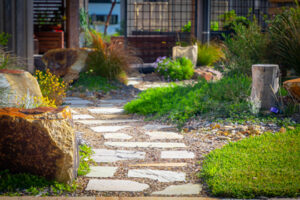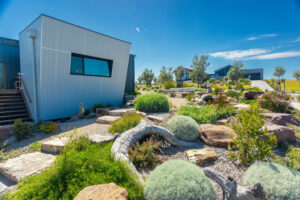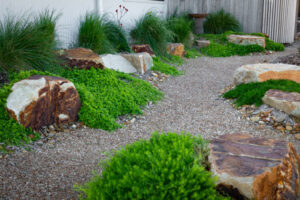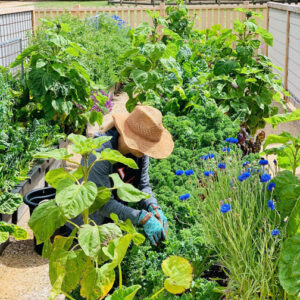
Three main factors of plant selection
By Georgia Warren
One of the first stages of designing a space is considering the placement of hard landscaping elements, such as decks, paths, paving, seating, and walls. Once the hardscape elements have been laid out, providing a structural “backbone” to the plan, planting can be considered. Plants breathe life into a garden, with clever species selection complementing the overall aesthetic or style of the space and creating a place that can be enjoyed for years to come.
When choosing plants for each unique project, take into consideration a wide range of factors when designing, to provide plants the best possible chance at thriving. There are a range of considerations to keep in mind, but there are three main factors and we explore them in this article.
Site analysis and choosing plants based on function
Choosing plants based on their location and function may seem simple, but there is more to this than meets the eye. Our landscape architects start all new projects with an initial consultation on site, to discuss the clients aspirations and at the same time conduct a site analysis. This involves noting down the various traits of the site such as sun position, wind, rainfall, slope, soil, existing vegetation, access, existing uses, etc, while thinking about how these factors interact with broader themes.

In gaining a deeper understanding of a site, landscape architects are better equipped to select plants that have the best possible chance at succeeding. This is key when it comes to choosing plants that need to satisfy the dual demands of functioning the way they are intended to in a design e.g., as screening plants, as feature specimens, as groundcovers etc, while also standing up to site-specific pressures such as climate. For this reason, native plants are often an ideal choice. In designing with native and indigenous plants we are selecting plant species that are uniquely suited to the climates and soils of the locations that they originate from.
Some native species are very resilient and good at adapting to diverse climatic conditions. This makes them versatile options in the face of a changing climate. This means that, overall, natives are often a more water-efficient and lower maintenance choice than non-native species, giving plants a better chance at long-term success than their non-native counterparts.
Get the look
The next factor that comes into play is the overall aesthetic or style of a design, and how plants can complement and emphasize that. During the initial consultation phase, we aim to understand and interpret the overall “look” and feel clients may want. Plants are what fills the gaps between the hard landscaping elements. With consideration to the first factor, largely focused on functionality, we select plants that suit the desired feel and “look”, harmoniously melding form and function. This means considering the colours of plants and their flowers, as well as foliage texture and shape, size, and form, as well as light and water requirements. Appropriate plant selection helps to achieve a successful outcome.

Planting for habitat infill and food production
The final factor that is considered is how the plants might satisfy more than just aesthetic outcomes. We create beautiful, biodiverse and resilient landscapes. While the landscaped public realm is characterised by street trees, nature strips, and open green spaces like parks, sports fields, and trails, the private realm encompasses property which is privately owned. The majority of land in most urban councils in Australia is privately owned. This means that while public landscapes have a significant role to play in providing amenity to us all, and habitat for native animals, there is an incredible opportunity to use our front and backyards to contribute to the broader landscape. We support this by designing, constructing, and maintaining landscapes that are not only beautiful, but also support biodiversity. Choosing native plants that are adapted to the area contributes to biodiversity by supporting the local ecosystem in providing food and shelter for native fauna such as butterflies, bees, mammals, reptiles, and birds. By landscaping with native and indigenous plants, as well as carefully placed habitat rocks and logs, we can create habitat infill throughout our urban environment and contribute to a range of other outcomes that are beneficial to humans and nature alike. Resilient and long-lived plants and trees absorb and transpire water, and provide shade, contributing to the urban cooling effect.

Resilience in a landscape can refer to using plants adapted to their environment. Being able to produce fruit and vegetables in an urban environment also builds resilience into a landscape. With the challenges of climate change, and extreme weather events such as floods and heatwaves, and the rising costs of vegetables, it is more important than ever for cities to grow local food. Partnering with our sister company Foodcube, we design and build urban vegetable and herb farms, and orchards, which can produce 25kg of fresh produce per square metre each year. Many fruits and vegetables require pollinators, such as bees. While many food plants, and supporting ornamental plants, flower in the warmer parts of the year, native plants often flower in the cooler parts of the year, making combining the two in your garden a smart choice to support pollinators for more of the year, and boost your harvest. When plants die or leaves fall, they can be composted, contributing to the circularity of a landscape, and further increasing resilience.
Plants bring gardens to life. Consider many factors when selecting plants for your landscape design. Among other factors, consider the location and function of plants in a garden, as well as the visual intent, habitat value, and food production capabilities of plants. Together, with these factors in mind, landscape architects can create beautiful, biodiverse, and resilient landscapes for living.
Here are some native plants that we love. Many of these plants provide habitat and food for butterflies, hoverflies, small skinks and lizards, native bees, birds, and frogs.
Dichondra repens – Kidney Weed
Chrysocephalum apiculatum – Common Everlasting
Pycnosorus globosus – Billy Buttons
Correa alba – White correa
Themeda triandra – Kangaroo Grass
Viola hederacea – Ivy leaf Violet
Banksia blechnifolia – Blechnum Banksia
Calocephalus lacteus – Milky Beauty-heads
Dichelachne crinita – Long hair plume grass
Myoporum parvifolium – Creeping Myoporum
Westringia fruticosa – Coastal Rosemary
Leucophyta brownii – Cushion Bush
Lomandra longifolia – Spiny-headed Mat-rush
Georgia Warren
Landscape Architect
The Sustainable Landscape Company P/L
M: 0429 347 585
E: georgiaw@theslc.com.au
Main photo: Appropriate plant selection helps to achieve a successful outcome.
